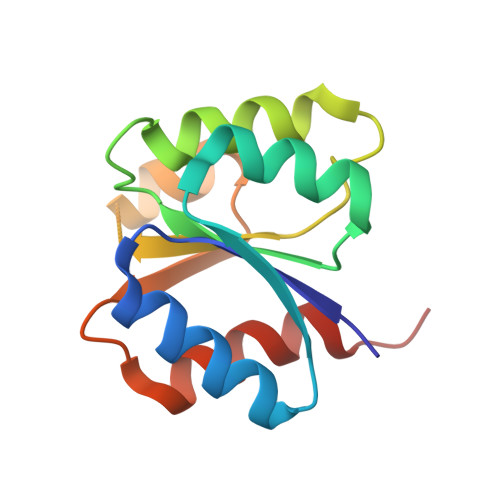Crystallographic and Biochemical Studies of DivK Reveal Novel Features of an Essential Response Regulator in Caulobacter crescentus.
Guillet, V., Ohta, N., Cabantous, S., Newton, A., Samama, J.-P.(2002) J Biological Chem 277: 42003-42010
- PubMed: 12176983
- DOI: https://doi.org/10.1074/jbc.M204789200
- Primary Citation of Related Structures:
1M5T, 1M5U, 1MAV, 1MB0, 1MB3 - PubMed Abstract:
DivK is an essential response regulator in the Gram-negative bacterium Caulobacter crescentus and functions in a complex phosphorelay system that precisely controls the sequence of developmental events during the cell division cycle. Structure determinations of this single domain response regulator at different pH values demonstrated that the five-stranded alpha/beta fold of the DivK protein is fully defined only at acidic pH. The crystal structures of the apoprotein and of metal-bound DivK complexes at higher pH values revealed a synergistic pH- and cation binding-induced flexibility of the beta4-alpha4 loop and of the alpha4 helix. This motion increases the solvent accessibility of the single cysteine residue in the protein. Solution state studies demonstrated a 200-fold pH-dependent increase in the affinity of manganese for the protein between pH 6.0 and 8.5 that seems to involve deprotonation of an acido-basic couple. Taken together, these results suggest that flexibility of critical regions of the protein, ionization of the cysteine 99 residue and improved K(D) values for the catalytic metal ion are coupled events. We propose that the molecular events observed in the isolated protein may be required for DivK activation and that they may be achieved in vivo through the specific protein-protein interactions between the response regulator and its cognate kinases.
- Groupe de Cristallographie Biologique, IPBS-CNRS, 205 route de Narbonne, 31077 Toulouse, France.
Organizational Affiliation:

















